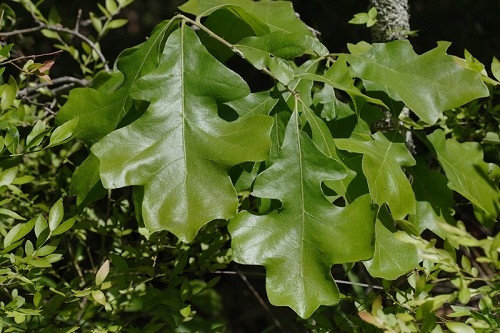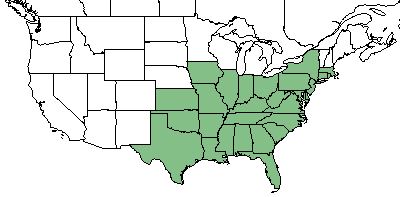Quercus stellata
Common name: post oak [1]
| Quercus stellata | |
|---|---|

| |
| Photo by John Gwaltney hosted at Southeastern Flora.com | |
| Scientific classification | |
| Kingdom: | Plantae |
| Division: | Magnoliophyta - Flowering plants |
| Class: | Magnoliopsida - Dicots |
| Order: | Fagales |
| Family: | Fagaceae |
| Genus: | Quercus |
| Species: | Q. stellata |
| Binomial name | |
| Quercus stellata Wangenheim | |

| |
| Natural range of Quercus stellata from USDA NRCS Plants Database. | |
Contents
Taxonomic Notes
Synonyms: Q. villosa Walter
Varieties: Q. stellata var. stellata
Description
Q. stellata is a perennial tree of the Fagaceae family native to North America.[2]
Distribution
Q. stellata is found in the southeastern corner of the United States from Texas to Massachusetts.[2]
Ecology
Habitat
Q. stellata proliferates in upland forests and woodlands, especially in clay or rocky soils and in communities at least formerly exposed to fire.[1] Specimens have been taken from mesic woodland, pine-oak stands, hardwood forests, second growth woodland with sandy soil, open pine oak woodland, and old growth pineland.[3] Q. stellata reduced its frequency and density in response to soil disturbance by roller chopping in northwest Florida sandhills. It has shown resistance to regrowth in reestablished sandhill habitat that was disturbed by this practice.[4]
Quercus stellata is frequent and abundant in the Clayhill Longleaf Woodlands community type as described in Carr et al. (2010).[5]
Phenology
Q. stellata has been observed to flower March through May and in November.[6] Native, perennial tree to 75.0 feet. Bark usually gray to gray-brown, relatively thick, irregularly fissured with narrow or broad scaly ridges; leaves deciduous, alternate, simple, stellate-hairy on lower surface, usually 5-7 lobed (not bristle tipped), the upper 3 lobes usually being the largest, usually having somewhat of a crosslike appearance; plants monoecious; inflorescences are catkins; fruit is a 1-seeded nut called an acorn, 1-2 clustered, cup enclosing 33-50% of the nut, maturing the first year in the fall.[7]
Fire ecology
Q. stellata is not fire resistant and has medium fire tolerance[2]; despite this, populations have been known to persist through repeated annual burns.[8][9]
Herbivory and toxicology
Quercus stellata has been observed to host planthopper species from the Achilidae family such as Catonia cinctifrons, and Catonia sp., as well as planthoppers from the Cicadellidae family such as Alebra aurea, Eratoneura acantha, E. ardens, E. parva, Hymetta balteata, Scaphytopius sp., Erythroneura beameri, and Flatormenis proxima (family Flatidae), cicadas such as Magicicada sp. (family Cicadidae), true bugs from the Delphacidae family such as Delphacodes puella and Liburniella ornata, Cedusa maculata (family Derbidae), and Zelus luridus (family Reduviidae), bees from the Membracidae family such as Atymna querci, Cyrtolobus fuliginosus, Cyrtolobus funkhouseri, Cyrtolobus fuscipennis, Cyrtolobus maculifrontis, Cyrtolobus ovatus, Cyrtolobus pallidifrontis, Cyrtolobus puritanus, Cyrtolobus tuberosus, Cyrtolobus vau, Glossonotus acuminatus, Ophiderma definita, Ophiderma pubescens, Ophiderma salamandra, Smilia camelus, Telamona decorata, Telamona monticola and Telamona westcotti, as well as plant bugs from the Miridae family such as Pseudoxenetus regalis and Plagiognathus modestus.[10]Q. stellata has low palatability for grazing and browsing animals.[2]
Conservation, cultivation, and restoration
Q. stellata is listed as a special concern species by the Rhode Island Department of Environmental Management.[2]
Cultural use
Acorns were an important staple for Native Americans in making flour for breads. The meat could also be edible once the tannins were leached from the acorns.[11]
Photo Gallery
References and notes
- ↑ 1.0 1.1 Weakley, A. S. (2015). Flora of the Southern and Mid-Atlantic States. Chapel Hill, NC, University of North Carolina Herbarium.
- ↑ 2.0 2.1 2.2 2.3 2.4 USDA Plant Database https://plants.usda.gov/core/profile?symbol=QUST
- ↑ URL: http://herbarium.bio.fsu.edu. Last accessed: June 2018. Collectors: Loran C. Anderson, Jack P. Davis, R.K. Godfrey, Gary Knight, Richard Mitchell, H. Kurz, Kurt Blum, Celeste Baylor, Chris Cooksey, R.F. Doren, R. Komarek, K.M. Meyer, A. Townsmith. States and counties: Florida (Leon, Nassau, Okaloosa, Escambia, Wakulla, Jackson, Gadsden, Liberty, Marion, Washington) Georgia (Thomas, Grady)
- ↑ Hebb, E.A. (1971). Site Preparation Decreases Game Food Plants in Florida Sandhills. The Journal of Wildlife Management 35(1):155-162.
- ↑ Carr, S.C., K.M. Robertson, and R.K. Peet. 2010. A vegetation classification of fire-dependent pinelands of Florida. Castanea 75:153-189.
- ↑ Nelson, G. PanFlora: Plant data for the eastern United States with emphasis on the Southeastern Coastal Plains, Florida, and the Florida Panhandle. www.gilnelson.com/PanFlora/ Accessed: 29 MAY 2018
- ↑ Gee, K. L., et al. (1994). White-tailed deer: their foods and management in the cross timbers. Ardmore, OK, Samuel Roberts Noble Foundation.
- ↑ Robertson, K.M. Unpublished data collected from Pebble Hill Fire Plots, Pebble Hill Plantation, Thomasville, Georgia.
- ↑ Platt, W.J., R. Carter, G. Nelson, W. Baker, S. Hermann, J. Kane, L. Anderson, M. Smith, K. Robertson. 2021. Unpublished species list of Wade Tract old-growth longleaf pine savanna, Thomasville, Georgia.
- ↑ Discoverlife.org [1]
- ↑ Fernald, et al. 1958. Edible Plants of Eastern North America. Harper and Row Publishers, New York.